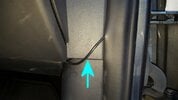@chumanji9
Looks like
@SomeJoe7777 hooked it up to the dome lights, but aparently (just browsing around) newer models don't handle this well; the wiring's become more of a pain and people tend to use the OBD2 connector.
Which brings about a bigger question: is the OBD2 connector for power sleep-safe? Will using that connector for juice result in a dead 12v battery if not managed properly? I kinda wish there was a page on weeks-long dashcam power sources for Teslas. ^o^
If it could regularly stay topped up w/o major vampire drain, a 4ch Blackvue setup would probably only sip some 12-15w, enough to go 2-3 weeks on what amounts to a 1-day Sentry Mode supply.
My understanding is the dome light is the only source that is always on (even without Sentry mode on) and still remains on even in the later models. The other sources (one of which is in the driver foot well) either disappeared in later versions hardware wise or are not always on.
How to: Model 3 Constant 12V for Dashcam
The dome light also is the most convenient location to tap into if you are installing a front/cabin camera, as you can run the cable through the headliner to the windshield and it's a very short run.
Note that the dome light drops to 9V when asleep so you need to be sure that your dashcam can tolerate that (Blackvues allegedly can, but this may not be true of others).
My understanding is there is no OBD2 connector in the Model 3, that solution was for the Model S/X that had it. Instead Model 3 has a CAN bus (underneath access panel under the rear seat air vents) and you need an adapter to get OBD, but it may not necessarily be the same as a true OBD2 connector in terms of the power connection (even if the data is the same).
All You Need to Know about the Tesla Model 3 & Y Diagnostic Tools and Apps
Teslatap says that OBD adapters for Model S/X stay on, but for Model 3/Y it turns off, so presumably that is not a reliable always-on 12V power source for Model 3/Y (even though it was for Model S/X).
Extracting Internal Vehicle Data – TeslaTap
Edit: I found the thread you were talking about. The OP in it seems to be talking about there being more wires in the Blackvue and he was confused about which ones to connect to.
Blackvue Dashcam 12v Constant power?
He seems to have connected yellow wire from dome to the red wire on the Blackvue side, which may either be ACC or the camera power, which may not correctly power the camera. For Blackvue, the yellow wire appears to be the Constant voltage wire and probably the one he should have connected to. There are also two black wires, one ground, one negative for camera. He should have connected to the ground one officially, but the camera negative may work also if they are tied together. I'm just basing this from below article, I'm not familiar with Blackvue, so don't take my word for it.
https://helpcenter.blackvue.com/hc/en-us/articles/360060768132-Power-Magic-Pro-Issues
There was no follow up so not sure if he resolved the issue. The easiest way to see if there is power on the car side is simply using a multi-meter to check the yellow and black wire of the dome connector (which still existed in his post) on the dome light for voltage. If there is power, then the issue is on the Blackvue side.
The later posts talking about OBD2 was from a X owner, not a Model 3 owner. It's easy to get things mixed up and assume things are universal, but as I pointed out above Model S/X is completely different from Model 3/Y.



